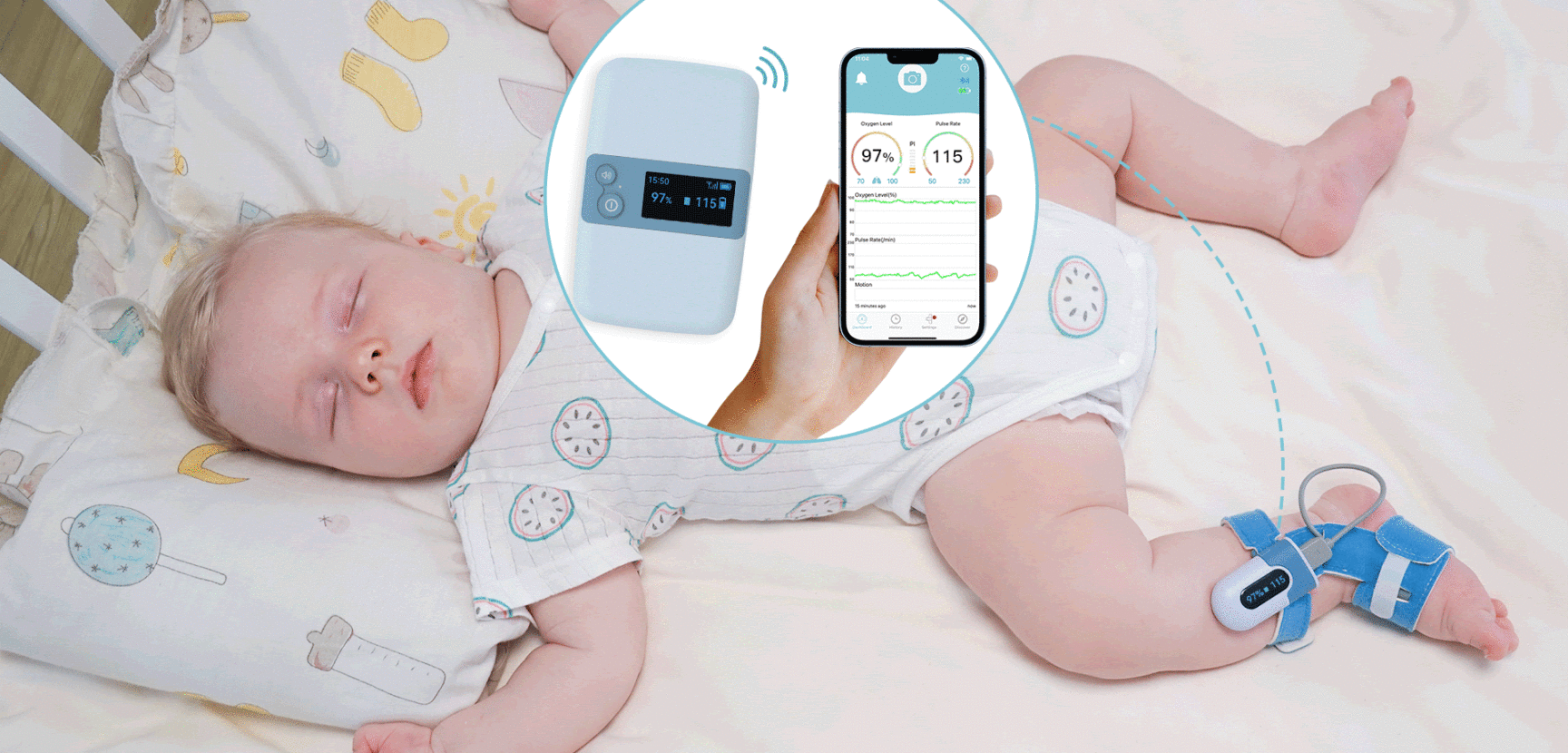Why Do You Need A Baby Oxygen Monitor?

Compared to adults, the respiratory status of newborns requires close attention. If a newborn is found to have hypoxia during delivery, it is even more important to monitor the blood oxygen status closely after the baby is discharged from the hospital. That is to avoid severe hypoxia from occurring and affecting the normal development of the baby. So new parents are worried to check for their baby’s breath all night. Then the oxygen monitor for baby is bought by new parents at home to monitor the infant’s blood oxygen levels and heart rate and to sound alarms when detecting abnormalities.
As new parents, there are some common questions and answers as follows that you need to know.
1. Manifestations of neonatal hypoxemia
The main manifestations of neonatal hypoxia are:
1. Increased or decreased respiratory rate;
The criteria for increased respiratory rate are: in the condition of calm without oxygen, (less than 2 months of age) ≥ 60 breaths/min, (2 months of age – 12 months of age) ≥ 50 breaths/min.
2. Over deep or shallow breathing: infants or newborns may show open-mouth breathing, moaning, grunting sound, nasal flaring, head bobbing.
3. Purple or gray lips and face;
4. Concave chest, etc.
2. What is the neonatal oximeter?
The neonatal oximeter is dedicated to monitoring the oxygen saturation and pulse rate of newborns. The pulse oximetry method is a simple and painless way to measure the oxygen level in the blood. Arterial oxygen saturation is an important parameter reflecting the respiratory function and whether there is hypoxia, and hypoxia can lead to many diseases, such as critical congenital heart disease and in serious cases, death, so real-time monitoring of blood oxygen is especially important for the health of newborns.
3. How do you perform a pulse oximetry measurement?
The pulse oximetry probe is wrapped in a wrap around the baby’s right hand or one foot. The probe is connected to a monitor that displays the oxygen levels, just like the Wellue BabyO2 S2 baby oxygen monitor. The Owlet smart sock doesn’t have a single monitor to screen because they use the phone APP.
Just bundle the oxygen probe on the baby’s dorsal foot, this location is relatively rich in arterial blood flow. Because the newborn body movement will affect the oxygen measurement, you can use a strap to tie the probe data cable at the ankle to fix it, reducing the role of sensor shaking, and then to monitor the baby’s blood oxygen status for a long time.
When the baby is calm and warm, it takes only a few minutes to obtain a reading. The number will take longer to obtain if the infant is crying, hypothermic and wet.
4. Why is the pulse oximetry method used to screen CHD (congenital heart disease)?
Congenital heart disease is a problem with the structure of the heart or the flow of blood through the heart. Congenital heart disease is the most common birth defect and is often asymptomatic in the newborn period.
Pulse oximetry can be used to determine the oxygen level in the blood and has been used to monitor the oxygen level in the blood of infants in special monitoring.
It can also indicate the infant’s cardiopulmonary function. Pulse oximetry can also help identify infants with severe congenital heart disease, infections and pneumonia. Infants with severe congenital heart disease, infections and pneumonia often have very low oxygen levels in their blood. If the newborn fails the screening test, the medical workers should use an echocardiogram to complete further diagnosis.
If the newborn fails the screening test, the provider should use an echocardiogram to complete further diagnosis.
5. What is the normal reading?
For oxygen saturation in the baby’s foot: ≥ 95%;
Infants with abnormal function or infection have low oxygen saturation readings. Sometimes low pulse oximetry caused by birth crush is normal. Your child’s physician may also do additional oxygen saturation measurements for the baby.
For resting heart rate (pulse rate):
• Newborns 0 to 1 month old: 70 to 190 beats per minute
• Infants 1 to 11 months old: 80 to 160 beats per minute
• Children 1 to 2 years old: 80 to 130 beats per minute
• Children 3 to 4 years old: 80 to 120 beats per minute
• Children 5 to 6 years old: 75 to 115 beats per minute
• Children 7 to 9 years old: 70 to 110 beats per minute
• Children 10 years and older, and adults (including seniors): 60 to 100 beats per minute
• Well-trained athletes: 40 to 60 beats per minute
6. Is it possible for an infant with severe congenital heart disease to have a normal pulse oximetry reading?
It is possible. Watch for the following symptoms in your child.
• Difficulty in breastfeeding
• Sweating around the head (especially while breastfeeding)
• Shortness of breath
• Pale or bluish skin
• Lethargy and immobility
• Swollen face, arms and legs
• Irritable or difficult to calm
Shop our Baby02 Oxygen Monitor today!
